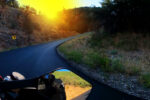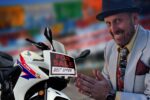ADV bikes are all rage these days and for good reason. They provide superb street-bike handling characteristics with a very neutral seating position that is easy on ones back but also allow riders to go off the beaten path and discover what lies beyond those tree’s after the pavement has ended.
The problem, however, is choosing the best tire. It wasn’t long ago that nobody was making a tire with the the dirt in mind but now, every manufacturer is making a 90/10 tire (90% pavement/10% off road). Even if one does not have aspirations of spending a great deal of time away from the comforts of asphalt, the idea of having a tire that can better deal with extensive road construction is very appealing.
The Trail Attack lines up nicely alongside the Metzeler Tourance, Michelin Anakee, Bridgestone Battlewing and Pirelli Scorpion Trail (of which, we’ve worn out many sets).
The Trail Attack isn’t a brand new tire. It’s been around for quite some time, although traditional sport-bike sizes are relatively new, but before we even wore out our first set of Trail Attacks on the Multistrada 1100, Conti released the Trail Attack 2, and made them available in a 190/55-17 rear, so we threw a set on the Multi 1200 and set out.
Brochure
Continental started using this thing they call “Traction Skin” a few years ago. Most new tires have an agent on the surface of the tire designed to help the tire come out of the mold. It’s called, cleverly enough, mold release. And anyone who’s fit a new set of tires will tell you, one has to take care until the mold release has worn off. Traction Skin eliminates that need. The tire comes from the factory with a textured surface that allows the rider to avoid all that pesky break-in time. With Traction Skin, you just start riding.

We’ve never been shy about our love of the Continental profile, long touting it as our favorite, light-steering while straight up and down, but becoming slower and more stable as the bike leans. However, for the Trail Attack, Conti has revised this to better suit the intended purpose of the tire.
Also new with the Trail Attack 2 is a slightly Revised tread pattern that Conti says was designed to facilitate precise handling and optimized wear. We get tired when brochures come out talking about how cool a tread pattern looks or what have you. We really don’t care. We want a tread pattern that is designed to enhance the performance of the tire, even if it’s the silliest looking pattern in the world; function over form.
More interesting than the tread pattern, however, Continental says they are employing a Revised Carbon Black Chili. It’s this magic “Carbon Black Chili” that Continental has been using for the last few years that helps the tire warm up, stick in wet and cold weather and, all around, help the tire deal with the forces and stresses a tire is faced with. Continental says this new “Carbon Black Chili” helps to improve the tires dynamic stiffness at high temperatures plus, they say, it provides a faster warm up time. To help the tire last a good long time they’ve used an “innovative new touring compound” that is said to provide good adhesion as well as good life, because the last thing any touring rider wants to worry about is finding new tires or changing tires while on the road.
Continental is also touting that the front tire has a reinforced carcass to help the tire deal with the challenges of having to be a tire for multiple surfaces, and this was easily confirmed when we fit the Trail Attack 2’s to the rims. The rear tire has a compliant, flexy carcass, while the front tire is significantly stiffer.
Finally, the Trail Attack 2 uses Continentals answer to the dual compound craze. Instead of taking multiple compounds, harder in the center and softer on the sides, and trying to glue them together they use Continuous Compound Technology. By controlling how the tire is cured, curing it at different rates and temperatures, the center of the tire is less flexible and more resistant to wear, while the shoulder of the tire is softer, grippier and more compliant. And because this is done through a curing process, the carcass changes gradually from the center to the shoulder, without any abrupt changes. This isn’t the first time we’ve experienced the Continuous Compound Technology and we can say, straight-faced, that it works brilliantly.
So now that we are up to speed on everything Continental says about the tire, it’s time we put it through the paces and see how what they say compares to how the tire performs in the real world.

The first thing everyone wants to know about is grip, and right off the bat the tire feels great. The compliant rear tire plants itself nicely into the asphalt and provides plenty of traction for even the most aggressive of acceleration on the asphalt. The difference in the new profile is subtle, the tire is more planted during straight-up riding but requires more effort to initiate tip-in, it’s not a dramatic change, but it helps the tire to feel very stable, and the slower rate of tip-in was appreciated when the road was gravel or crumbly tarmac.
On the dirt, the tire performs better than you’d expect it to. This isn’t a open-lug knobbly tire, but you can tell it was designed with the dirt in mind. Spirited riding on graded roads and even into mild two-track, the tires do a great job of keeping you going (and slowing) without a whole lot of fuss. In fact, the tire’s behavior off the beaten path exceeded our expectations and soon we were able to forget about what the tires were doing and started enjoying the ride and the scenery.
What’s more, the stiff front tire provided impressive levels of confidence during braking, on and off the road. We surmise that by being a little stiffer, the carcass was better able to handle the added weight without too much deformation, allowing us to scrub off lots of speed quickly with confidence.

We also noticed that the tire does warm up fairly quickly, which is nice, but whats even nicer is how warm the tire stayed during colder riding and in wet conditions. Even with snow still on the side of the road and a road surface that was chilled from being in the shade all day, the tire maintained very consistent levels of grip, something that is very important for the adventurous rider who may see four-seasons of riding in a single day.
The wear on the tires was surprisingly good. Reports coming from Europe claim the rear tire is lasting around 5,500 miles while the front is holding up for around 7,500. We didn’t get quite that much life out of them, but it’s important to note that how long a tire lasts is very dependent upon how fast one rides and how abrasive your local roads are. Our local roads are well known for being so abrasive that our tire life is shortened by around 20 to 30 percent, and well, we really like to turn that go-fast knob, which is hard on tires as well.
The tires did show weakness in one area, on the asphalt the stiffer front carcass became apparent as the speeds increased, specifically in canyon/cornering settings. The differences in between the front and rear tire could be felt, particularly during heavy trail braking, especially into steep, downhill corners. It was during these conditions that handling became a bit of an issue with the stiffer front tire unable to provide much feedback, it was too easy to push front tire too hard.

At first we were pretty disappointed, but the more we thought about it, the more it started to make sense. When we stepped back and thought about what this tire was designed for and what its intended purpose was, the “flaw” makes more sense.
This tire wasn’t designed to be a hyper-sport, track-day tire, but as an all around adventure tire. The stiff front carcass that limited high-speed street shenanigans is exactly what made it work so well in the gravel and under braking. The stiff front tire protects the aluminum wheel from unexpected hits from big rocks and ruts as well as manages to keep a heavier bike stable and planted when its time to slow down.
Summary
In summary, despite so much excitement, it took us some time to come to terms with the Trail Attack and the Trail Attack 2; because of the differences in carcass stiffness the front tire struggles with grip and handling during spirited on-road riding. But that’s not what this tire was designed for. The Trail Attack 2 promises to be a Dual-Sport Enduro tire, which is exactly what it is. This tire is ideal for the adventure touring rider where the road may turn to gravel at any time, but since the Trail Attack 2 also comes in traditional sport-bike sizes riders who may not have big adventure bikes, but love to attach their fly-rod to their back seat and wander down gravel side roads looking for a secluded fishing spots, can also rejoice.

This tire can handle the paved twisty mountain roads that get you away from the city as long as they are run at conservative speeds, but where they shine is that they can also take you down that dirt road you’ve always wanted to see what was on the other side.
For more information visit the Continental Trail Attack 2 webpage.






